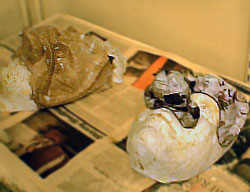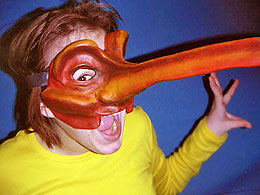Full or half masks, open or covered, animal masks, character masks, Commedia dell’Arte masks, zero masks, neutral masks, masks for theatre training, for rehearsals, to hang on a wall or masks for a specific performance – we can make most kind of masks, for most occasions. I always work in papier-mâché though.
This workshop is extremely flexible. I can either continue through the whole course to help when the participants make their masks and help to plan, give shape to or design the masks or I can just come in as a consultant to set up the work and then come every now and then to help the group in its work. We can also make different kinds of masks in different styles, for example start with a set of Commedia dell’Arte masks. Naturally it depends on the participants own preparations, previous knowledge, interest and ambitions how comprehensive the workshop will be.
We also have the possibility to work with different types of masks, but for material we always use papier-mâché, since it is the easiest technique and demands the least space, tools, material and so on. On the other hand we can use papier-mâché as a foundation and go further and add other materials such as hair or fur, glass or plastic details, leather or cloth and so on etc.
Even though the workshop can be adapted I want to explain a sort of standard process in short to make clear how the workshop is done.
We start by a going through the different kinds of masks and how they are used, what is important in each mask and some easy mask techniques. Then we start by making a plaster mask on each participant, either just in the face or over the whole head. Then we strengthen that mask and use it as a mold to cast a positive of each participants face or head.

The positive is now used to put clay on and model the mask we want. On this we now lay a number of layers of papier-mâché. When the papier-mâché has dried it is time to take out the clay and to take out and clean the mask. The mask shall now be ”framed” with paper to protect it and to put on an elastic band. Now it is time sand it until it is smooth and even.
After that we paint the mask, first inside with enamel paint, then on the outside. Depending on style, context and taste we can choose what kind of color and techniques we want to use when painting. Finally it is time to add decorations as hair, teeth, eyes or what is suited, but also to make filling inside the mask to make it more comfortable to wear.
Each participant shall have the knowledge to be able to construct and design their own masks after the workshop. They shall also have enough understanding of mask making to be able to develop their mask making. Furthermore each participant shall receive at least one mask and their own plaster positive, to continue working from, after the conclusion of the workshop.
If you are interested in this workshop click HERE


Pingback: Commedia dell’Arte masks design, materials and costume - Commedia dell'Arte & Vulgar ComedyCommedia dell'Arte & Vulgar Comedy